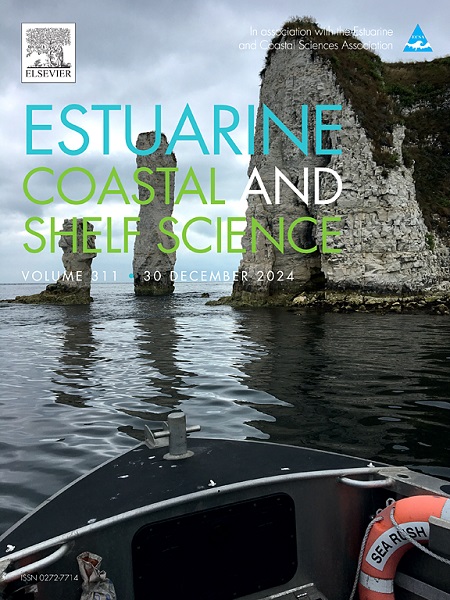土壤深度、潮位和林龄对恢复无瓣海桑红树林微生物群落结构和功能多样性的影响
IF 2.6
3区 地球科学
Q1 MARINE & FRESHWATER BIOLOGY
引用次数: 0
摘要
人工种植无瓣海桑是红树林恢复的常用方法,但种植时间和潮汐水平对土壤微生物群落的影响尚不清楚。研究了珠海七岙岛2个潮位无植被泥滩和无瓣蒿林分(12- 18)土壤微生物群落。通过16S rRNA基因测序和bio - eco分析土壤表面(0-10 cm)和底部(40-60 cm)的微生物组成和功能。结果表明,由于土壤总有机碳(TOC)、总氮(TN)和微生物生物量碳(MBC)的增加,表层土壤微生物多样性随着修复时间的延长而显著增加。TOC、TN和MBC影响表层土壤微生物群落的变化,而溶解有机碳(WSOC)和硝态氮(NO3−-N)影响底层土壤微生物群落的变化。下层土壤以厚壁菌门和弯曲菌门为主,表层土壤以变形菌门和绿菌门为主。功能预测表明,甲醇氧化和几丁质水解在表层土壤中富集,而底土则表现出更强的硝化和厌氧氨氧化潜力。这些发现揭示了种植年龄和潮汐梯度对红树林恢复过程中土壤微生物群落的调节作用。这些见解支持无瓣草可持续恢复和改善红树林恢复战略。本文章由计算机程序翻译,如有差异,请以英文原文为准。

Microbial community structure and functional diversity affected by soil depth, tidal levels, and stand ages in restored Sonneratia apetala mangroves
The artificial planting of Sonneratia apetala is commonly used for mangrove restoration, but the impacts of planting duration and tidal levels on soil microbial communities remain unclear. This study investigated soil microbial communities in unvegetated mudflats and S. apetala stands (12- and 18-year-old) at two tidal levels on Qi'ao Island, Zhuhai. Surface (0–10 cm) and bottom (40–60 cm) soils were analyzed via 16S rRNA gene sequencing and Biolog-ECO assays to assess microbial composition and functions. Results showed that microbial diversity in surface soils significantly increased with restoration duration, driven by elevated the soil total organic carbon (TOC), total nitrogen (TN), and microbial biomass carbon (MBC). TOC, TN, and MBC shaped microbial community changes in surface soils, while dissolved organic carbon (WSOC) and nitrate nitrogen (NO3−-N) influenced bottom soils. Firmicutes and Campylobacterota dominated subsoils, while Proteobacteria and Chloroflexi prevailed in surface soils. Functional predictions indicated methanol oxidation and chitinolysis were enriched in surface soils, whereas subsoils exhibited enhanced potential for nitrification and anaerobic ammonia oxidation. These findings reveal how planting ages and tidal gradients regulate soil microbial communities during mangrove restoration. These insights support sustainable S. apetala rehabilitation and improved mangrove rehabilitation strategies.
求助全文
通过发布文献求助,成功后即可免费获取论文全文。
去求助
来源期刊
CiteScore
5.60
自引率
7.10%
发文量
374
审稿时长
9 months
期刊介绍:
Estuarine, Coastal and Shelf Science is an international multidisciplinary journal devoted to the analysis of saline water phenomena ranging from the outer edge of the continental shelf to the upper limits of the tidal zone. The journal provides a unique forum, unifying the multidisciplinary approaches to the study of the oceanography of estuaries, coastal zones, and continental shelf seas. It features original research papers, review papers and short communications treating such disciplines as zoology, botany, geology, sedimentology, physical oceanography.

 求助内容:
求助内容: 应助结果提醒方式:
应助结果提醒方式:


